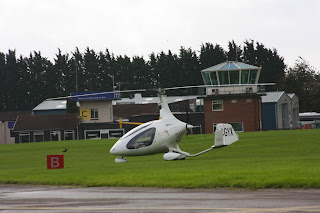 |
| Patrick and Me in the H3 with H2S in the background |
Very nice machines - especially the H2S which has a 180 hp Subaru engine and a gross weight of 700 kgs. A really fun helicopter to fly and quite responsive. More on this in the next copy of Helicopter Life out in Spring 2014.
The helicopter designer Jacky Tonet started this design in 2006, and the H2S was launched this year, shortly followed by the VLH design the H3.
I also flew the H3 and found that a lot lighter on the controls. It is still a nice helicopter but you have to work harder with the H3 as the power to weight ratio is lower, owing to the necessity of keeping the Gross weight below 450kgs. The tail rotor on both machines is really effective. Both machines rev over 5,000 rpm so the tail rotor is a little noisy, but it works well.
Both helicopters are extremely good value for their class - the H3 being a bit over 100 thousand Euros and the H2S another 30 thousand above that. You can build a kit, as required by some countries, but Dynali prefer it if you either build your machine either in their factory, or receive training from their engineers. There are also factory built models but these are uncertified and so would not be allowed in the UK. Other countries have different regulations. Dynali prefer selling the factory built models as they feel this is safer.
 |
| Junior performing his ground staff duties! |
















































